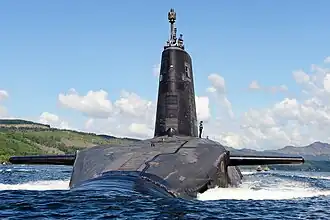Portal:Nuclear technology/Articles/52

Trident, also known as the Trident nuclear programme or Trident nuclear deterrent, covers the development, procurement and operation of submarine-based nuclear weapons in the United Kingdom. Its purpose as stated by the Ministry of Defence is to "deter the most extreme threats to our national security and way of life, which cannot be done by other means". Trident is an operational system of four Vanguard-class submarines armed with Trident II D-5 ballistic missiles, able to deliver thermonuclear warheads from multiple independently targetable re-entry vehicles (MIRVs). It is operated by the Royal Navy and based at Clyde Naval Base on the west coast of Scotland. At least one submarine is always on patrol to provide a continuous at-sea capability. The missiles are manufactured in the United States, while the warheads are produced by the British Atomic Weapons Establishment.
The missiles have a intercontinental range of 11,300 kilometres (7,000 mi). Up to 16 missiles can be carried by each submarine, and each missile can carry eight total warheads in MIRV configuration. The warheads have a yield of 100 kilotons of TNT. From 1995 to sometime before 2021, a 10 kiloton sub-strategic yield option was included on one missile per submarine. The design, codenamed Holbrook, is believed to be based on the American W76 warhead used on its own SSBNs.
The British government initially negotiated with the Carter administration for the purchase of the Trident I C-4 missile. In 1981, the Reagan administration announced its decision to upgrade its Trident to the new Trident II D-5 missile. This necessitated another round of negotiations and concessions. The UK Trident programme was announced in July 1980 and patrols began in December 1994. Trident replaced the submarine-based Polaris system, in operation from 1968 until 1996. Trident is the only nuclear weapon system operated by the UK since the decommissioning of tactical WE.177 free-fall bombs in 1998.
NATO's military posture was relaxed after the collapse of the Soviet Union in 1991. Trident warheads have never been aimed at specific targets on an operational patrol, but await co-ordinates that can be programmed into their computers and fired with several days' notice. Under the Nassau Agreement, UK nuclear weapons are committed to the defence of NATO.
The programme's acquisition cost was £12.52 billion (approximately £23 billion in 2024/25 prices), and its annual cost is estimated at £3 billion. The submarines' service life, designed as 25 years, will exceed 36 years. On 18 July 2016, the House of Commons voted by a large majority to proceed with building a fleet of Dreadnought-class submarines, to be operational by 2028, with the current fleet completely phased out by 2032.
Critics argue that geopolitical threats do not necessitate the high cost of Trident, or that threat or use of strategic nuclear weapons is unethical and likely to violate international law. According to YouGov, as of June 2025, 50% of British adults support replacement of Trident with an equally powerful system. (Full article...)